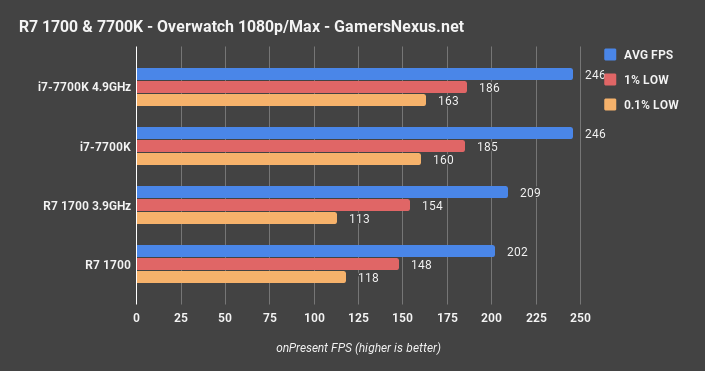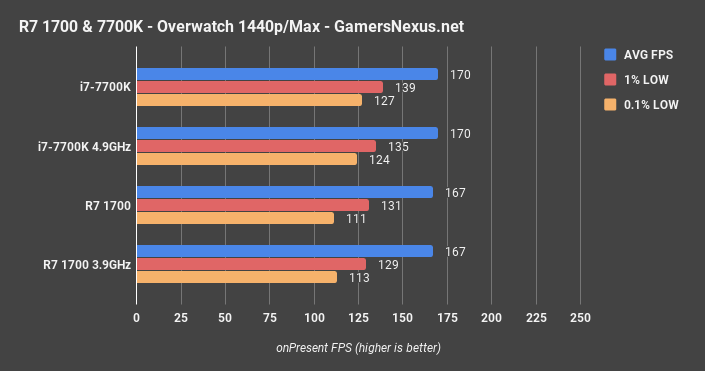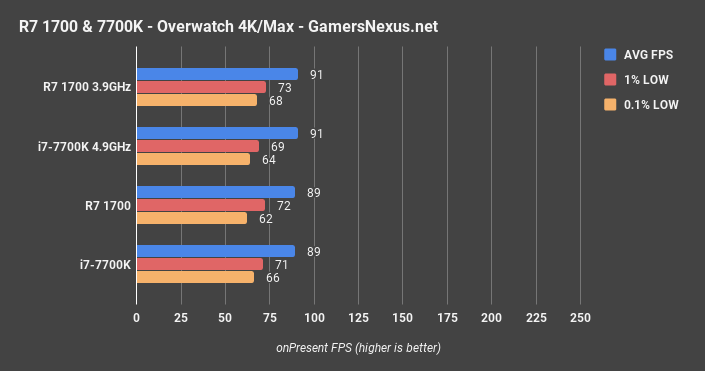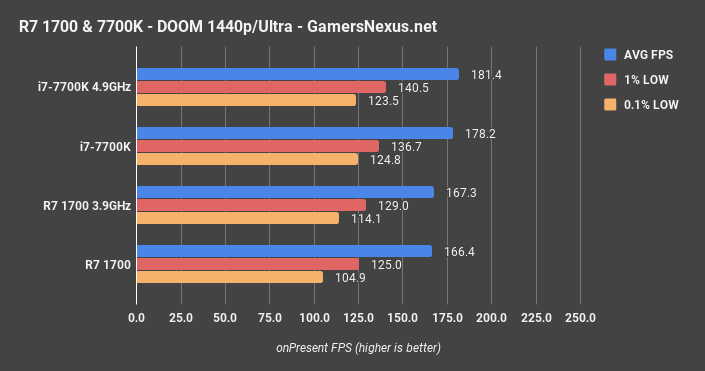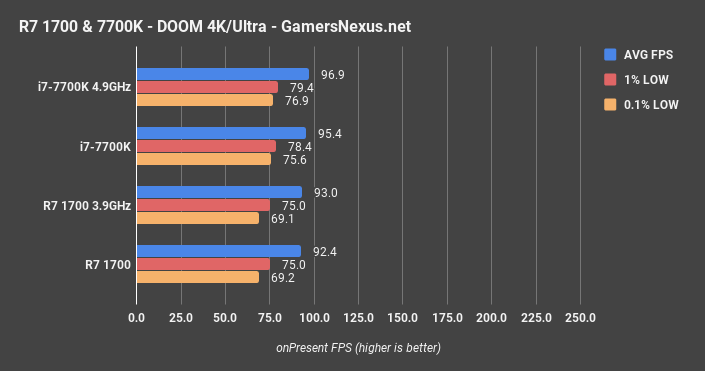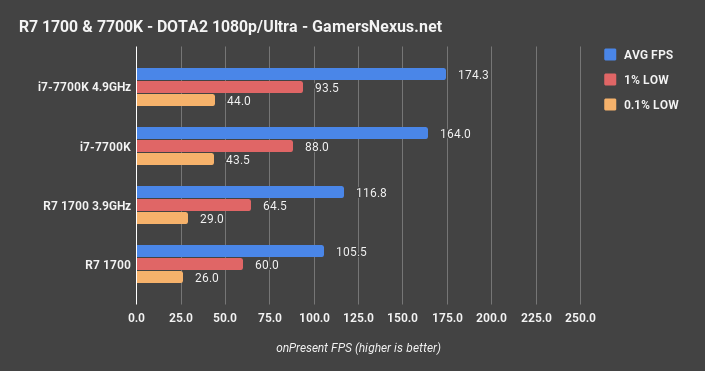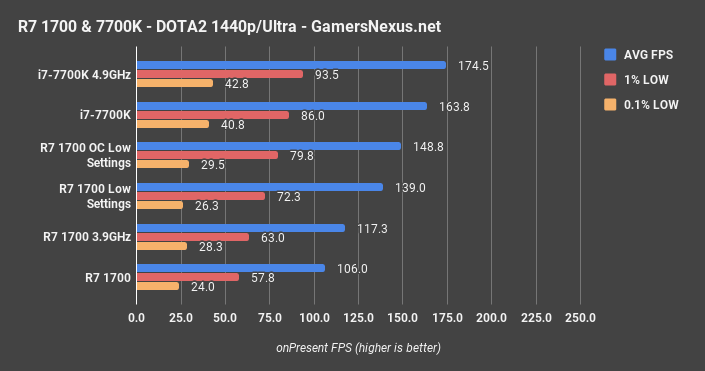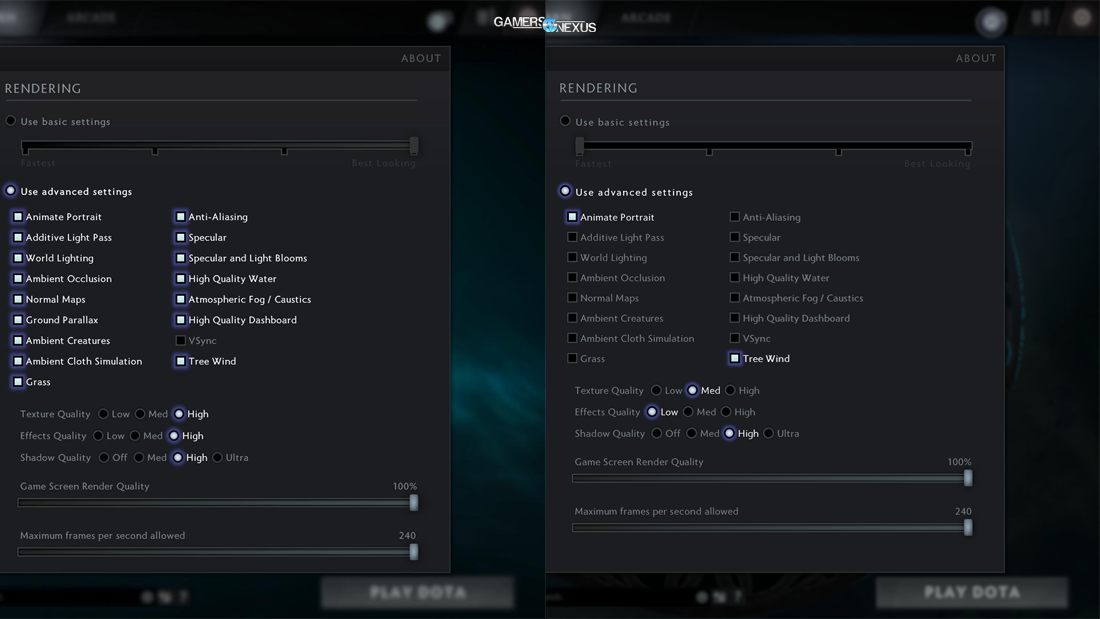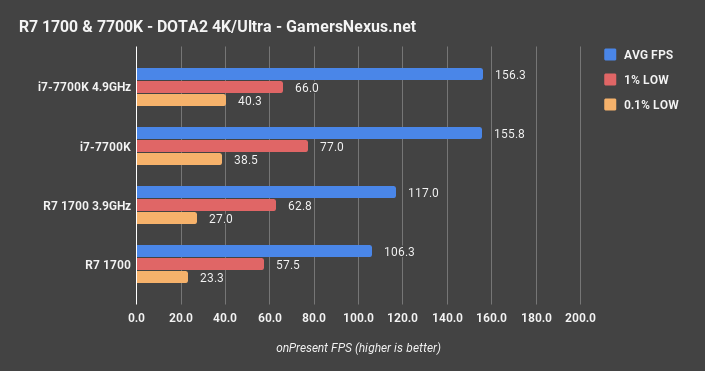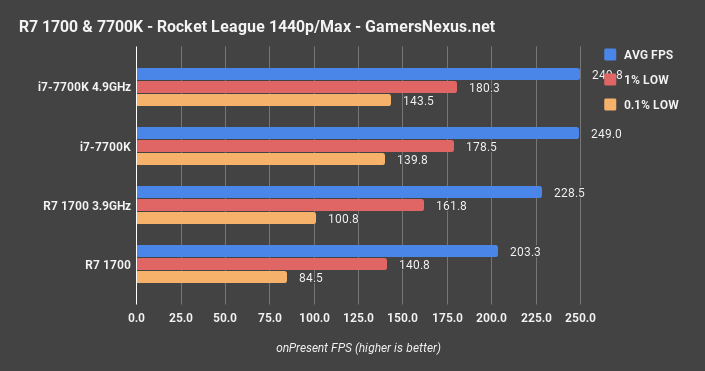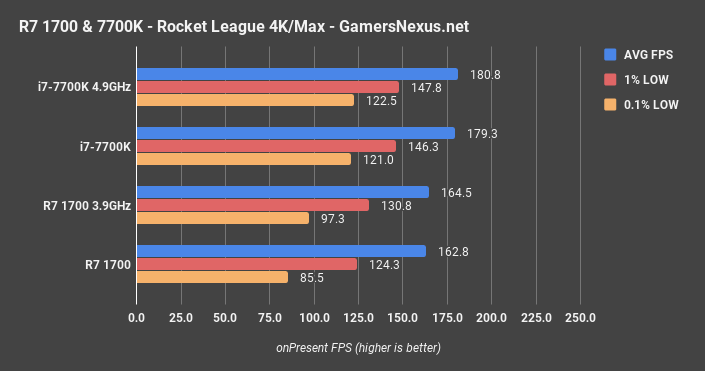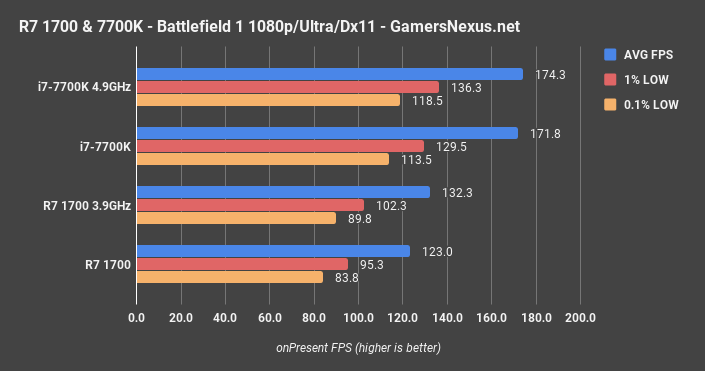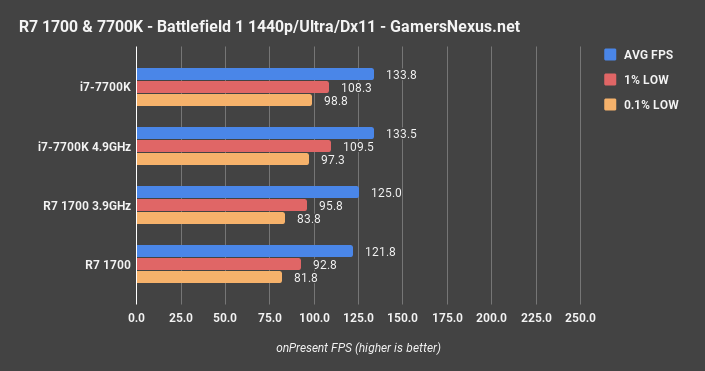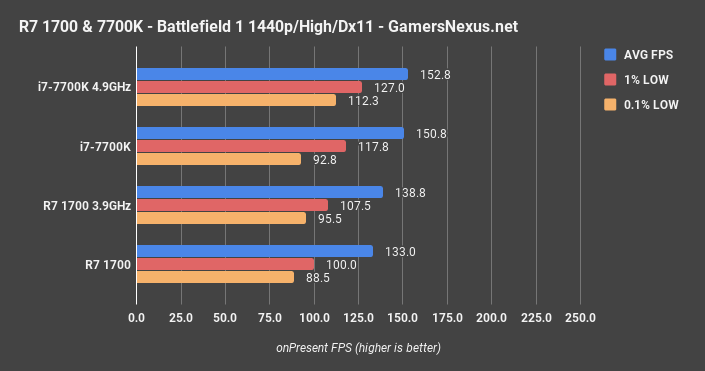Our recent R7 1700 vs. i7-7700K streaming benchmarks came out in favor of the 1700, as the greater core count made it far easier to handle the simultaneous demands of streaming and gameplay without any overclocking or fiddling with process priority. Streaming isn’t the whole story, of course, and there are many situations (i.e. plain old gaming) where speed is a more valuable resource than sheer number of threads, as seen in our original 1700 review.
Today, we’re testing the R7 1700 and i7-7700K at 1440p 144Hz. We know the i7-7700K is a leader in gaming performance from our earlier CPU-bottlenecked 1080p testing; that isn’t the point here. We’ve also pitted these chips against each other in VR testing, where our conclusion was that GPU choice mattered far more, since both CPUs can deliver 90FPS equally well (and were effectively identical). This newest test is less of a competition and more of a “can the 1700 do it too” scenario. The 1700 has features that make it attractive for casual streaming or rendering, but that doesn’t mean customers want to sacrifice smooth 144Hz in pure gaming scenarios. As we explain thoroughly in the below video, there are different uses for different CPUs; it’s not quite as simple as “that one’s better,” and more accurately boils down to “that one’s better for this specific task, provided said task is your biggest focus.” Maybe that’s the R7 1700 for streaming while gaming, maybe that’s the 7700K for gaming -- but what we haven’t tested is if the 1700 can keep up at 144Hz with higher quality settings. We put to test media statements (including our own) that the 1700 should be “better at streaming,” finding that it is. It is now time to put to test the statements that the 7700K is “better at 144Hz” gaming.
This series is an ongoing venture in our follow-up tests to illustrate that, yes, the two CPUs can both exist side-by-side and can be good at different things. There’s no shame in being a leader in one aspect but not the other, and it’s just generally impossible given current manufacturing and engineering limitations, anyway. The 7700K was the challenger in the streaming benchmarks, and today it will be challenged by the inbound R7 1700 for 144Hz gaming.
People like to make things a bloodbath, but just again to remind everyone: This is less of a “versus” scenario and more of a “can they both do it?” scenario.
We chose five popular games that we expected to run at 144 frames per second, even at high resolutions: DOOM, DOTA2, Rocket League, Overwatch, and Battlefield 1. Again, “success” for the 1700 here is defined as just keeping up with the 7700K, which surpassed it in 1080p gaming benchmarks.
| GN Test Bench 2017 | Name | Courtesy Of | Cost |
| Video Card | EVGA GTX 1080 Ti FTW3 | EVGA | $780 |
| CPU | Intel i7-7700K | Silicon Lottery | $330 |
| Memory | Corsair Vengeance LPX 3200MHz | Corsair | $320 |
| Motherboard | Gigabyte Aorus Gaming 7 Z270X | Gigabyte | $240 |
| Power Supply | NZXT 1200W HALE90 V2 | NZXT | $300 |
| SSD | Plextor M7V Crucial 1TB | GamersNexus | - |
| Case | Top Deck Tech Station | GamersNexus | $250 |
| CPU Cooler | NZXT Kraken X62 | Asetek | - |
| GN Test Bench 2017 | Name | Courtesy Of | Cost |
| Video Card | EVGA GTX 1080 Ti FTW3 | EVGA | $780 |
| CPU | AMD R7 1700 | GamersNexus | $291 |
| Memory | Geil EVO X 3200MHz | AMD | - |
| Motherboard | Gigabyte Aorus X370 Gaming 7 (Latest BIOS as of writing) | Gigabyte | $240 |
| Power Supply | NZXT 1200W HALE90 V2 | NZXT | $300 |
| SSD | Plextor M7V Crucial 1TB | GamersNexus | - |
| Case | Top Deck Tech Station | GamersNexus | $250 |
| CPU Cooler | NZXT Kraken X62 | Asetek | - |
We’ve never tested Rocket League before, so we had to develop new methodology on the spot. We downloaded a competitive 3v3 replay from season 5 (on map Neo Tokyo) and verified that watching the replay from a player’s POV was roughly comparable to actually playing a match.
Overwatch has introduced a replay system between the writing of this article and its publication, which we will be experimenting with in the future. For these benchmarks we used our original methodology as described in our optimization guide. Because some people have not read previous content pieces, we're re-stating this again: We test Overwatch for 5 minutes in a bot match on Numbani, engaging in combat with medium bots and averaging multiple passes for parity.
In Battlefield 1 we deviated from our standard methodology slightly by engaging in a combat scene with multiple actors on-screen, creating a more stressful and realistic test. These numbers can’t be directly compared to our other BF1 benchmarks.
Overwatch 1440p 144Hz Benchmark - R7 1700 vs. i7-7700K
Overwatch is one of the games with an unfortunate FPS cap: 300, in this case, but we don’t often approach that. The game does provide a beautiful demonstration of bottlenecking.
At 1080p, the resolution we usually test at, the 7700K has a hefty 22.2% higher FPS average than the 1700. At 1440p and 4K though, FPS is virtually unaffected by overclocking or choice of CPU: 1440p averages 167-171 FPS, while 4K averages 89-91 on both CPUs.
Starting at 1080p with max settings, we’re hitting 246FPS AVG on both the stock and overclocked 7700K, as we’re up against other limits here. These two are effectively identical in performance and fall within our error bars. The R7 1700 is capable of achieving our 144Hz goal, though the low-end frametimes do dip down below 144Hz, if that matters to you – this becomes a game of perception and subjectivity, and speaking subjectively, we don’t much notice the difference. There are certainly folks who think they see one, though, and it’s up to you to know whether you fit in that crowd. Both these CPUs can sustain 200Hz displays at 1080p, if desired. The 7700K is a much better option if higher quality settings at 240Hz are desired; although that 240Hz market is insanely small, the few who are truly fanatical about frames would still want to opt for the 7700K in this particular title. Otherwise, the 1700 is doing OK at 1080p.
Let’s move to 1440p.
At this resolution, everything levels out to perform within a couple percentage points in average framerate. The 7700K is technically leading, but it’s close enough to be within our margins for this particularly long test. The R7 1700 is consistently worse in frametimes, measurably and repeatedly, though not in a matter which is appreciable. Both CPUs are capable of sustaining 144Hz at 1440p.
Here’s 4K, just to show it. We are completely within test margins here, and can reliably state that this is completely GPU limited, as you’d expect. This has become a GPU benchmark, and as we’re using the same card for all tests, we’re seeing the same performance. Differences here are statistically insignificant and should not be read into further than “effectively identical.”
DOOM 144Hz Benchmarks - R7 1700 & i7-7700K
Doom is the next test up, and possibly one of the most forgiving, as it runs notoriously well on just about anything. For these tests, we used the Ultra preset with Vulkan and asynchronous compute, which is enabled when AA is off. The game is well-optimized to a point of being difficult to benchmark at times, particularly given its 200FPS physics bug that causes framerate to lock. The closer we get to 200FPS, the less accurate our top-end results will be as the framerates are capped. For this reason, testing 1080p is pointless.
At 1440p, both CPUs kept their average well above 144 FPS, even without any overclocking. When overclocked, both showed very small improvement over their stock speeds. Still, at stock speeds the 7700K’s average framerate was 7.1% higher than the 1700’s, and with both chips overclocked it was about 8.4% higher. The CPU is beginning to bump into the 200FPS limiter in some scenes, so this is truncated a bit. Theoretically, it would make sense if the 1700 and 7700K performed identically, since they aren’t the limiting factor here and most other hardware is the same between test systems (see test methodology described earlier).
Regardless, it’s clear that either CPU could reasonably achieve ultra settings at 1440p/144Hz in DOOM, and so we meet our objective on both the R7 1700 and i7-7700K, despite the latter’s 8% lead.
Overclocking also had minimal effect at 4K, but the 7700K’s advantage shrank to 3.2% stock and 4.2% OC as the high resolution shifted the burden even more heavily onto the GPU. Although we can deduce the primary source of a bottleneck easily, things aren’t always black and white. Factors like IPC or unavoidable hardware (i.e. motherboard, and potentially DPC timing) changes can make two systems technically limited by the same GPU behave differently. The R7 1700 and i7-7700K are effectively identical in performance, with regard to appreciable differences, and neither is capable of holding 144Hz. We’d have to lower settings or resolution to get that.
DOTA2 1440p / 144Hz Benchmarks - R7 1700 vs. i7-7700K
DOTA2 is tested differently in this benchmark, and for a different duration, than in previous tests. This makes results incomparable to past tests.
The core of our most recent 1700 vs 7700K streaming test was DOTA2, so it’s only fair that the game makes a return here. As a side note, because of this 144Hz testing, we discovered a typographical error in one of our streaming benchmark graphs pertaining to the 1700’s baseline FPS – that’s been corrected in the article with a note, though the conclusion remains unaffected. Basically, the R7 1700’s baseline performance when not streaming was lower than we originally though, but streaming performance was unaffected and remained the same, since it was just a typo on the baseline item.
That cleared away, let’s start with 1080p and Ultra settings, where we’ve manually maxed the game, DOTA2 shows clear favor to the i7-7700K in both its stock and overclocked configurations. We’ll later turn down some settings to try and achieve that 144FPS marker. As you can see, the 7700K is clearly ahead in this title under current conditions.
We’re at 174FPS AVG on the 4.9GHz 7700K, with the stock CPU at 164FPS AVG. 1% and 0.1% low metrics are always distant in DOTA2, but are higher with the Intel part than the R7 1700. The 1700 is clearly limiting GPU performance here, where we’re seeing a 117FPS AVG when overclocked to 3.9GHz and 106FPS AVG when in stock clocks. This places the overclocked 7700K 49% ahead of the overclocked 1700, with the stock 7700K about 55% ahead of the stock 1700.
Let’s move on to the star of the show: 1440p at 144Hz. The stock R7 1700 performs at about 106FPS AVG – roughly the same as we saw at 1080p, indicating that we’re still choking. Overclocking gets us also roughly the same, within test variance, at 117FPS AVG. The i7 CPUs haven’t really changed here, either – we’ll see more of a change at 4K, once a GPU bottleneck is instantiated. For now, we’re clearly CPU bottlenecked on all of these parts.
We wanted to know what settings would be required to get the R7 1700 CPU up to 144FPS and achieve our 1440p144Hz goal, so dropped settings as indicated on the screen above. With our low settings, we’re able to free-up enough of the CPU to ascend to 149FPS AVG when overclocked, and nearly 140FPS AVG stock. That’s getting about to where our target is – so dropping settings to low and overclocking pushes beyond 144Hz territory on the 1700.
Just to close this one out, here’s a 4K chart. GPU bottlenecks finally enter play, choking the 7700K down to 156FPS AVG. The R7 1700 sits where it has for the past two charts, as the CPU is clearly the limiting factor here.
The 1700 was CPU limited in all of its own tests and didn’t hit the 144 FPS mark even at 1080p. By turning settings down and overclocking, we finally broke that barrier, but DOTA2 doesn’t have a massive range for improvement when working with a CPU bottleneck. This is a common problem--graphics options often cater more to GPU limitations. The 7700K took this test despite Dota 2’s deceptively simple graphics.
Rocket League 1440p / 144Hz Benchmarks - R7 1700 & i7-7700K
Rocket League is an extremely undemanding game but (without modification) its maximum framerate is capped at 250 FPS. At 1440p, the stock 7700K was already at 249 FPS average, limiting its usefulness as a comparison--there’s no telling what it would be running at without the artificial cap. The stock 1700 managed 203.3 FPS, CPU limited as proved by the average improving 12.4% with an overclock, although these numbers could be higher without a cap. At 1440p, we’re able to achieve 144Hz playback – actually, 200Hz playback – on the R7 1700 and 7700K alike. The 7700K carries tighter frametimes for overall greater frame delivery consistency, and so there’s an argument to be made for keeping even low-end performance toward 140FPS – but the averages are passing on both the 1700 and 7700K, particularly after overclocking.
At 4K, both systems became GPU limited, with the 7700K stuck at about 180 FPS regardless of overclock and the 1700 at 163-165 FPS. Every single test exceeded 144 FPS regardless of resolution, again giving the 1700 a pass.
Battlefield 1 1440p/144Hz Benchmarks
Battlefield 1 is the last benchmark. These tests are conducted differently from our standard Battlefield benchmarks, and so are not at all comparable to past data. This test is run using a more intensive scene involving heavier combat that’s recorded over a longer period of time. It’s not quite what you’d get in a 64-player server, but is as close as we can reliably get without introducing uncontrollable variables.
Battlefield, although it’s one of the less demanding benchmarks from our standard run, made it difficult to achieve our 144 FPS goal. At 1080p ultra, the 7700K neared BF1’s FPS limit of 200, but dropped sharply below 144 FPS with the resolution increased to 1440p. At 1080p, the i7-7700K leads at 174FPS AVG overclocked, or 172FPS AVG stock. This positions the CPU beyond 144Hz territory, with the R7 1700 falling just below at 132FPS AVG overclocked and 123FPS AVG stock. Low-end frametimes sit behind the 7700K.
At 1440p/Ultra settings, the 7700K becomes more GPU-bound and limits to 133-134FPS AVG, with results between the stock and overclocked variants outputting effectively equally thanks to the GPU limitation. The R7 1700 now operates in the range of 122FPS to 125FPS AVG. Regardless of vendor, neither CPU is hitting 144Hz at 1440p, so we next tried dropping to 1440p and High settings.
When the quality preset was lowered to “high,” the average rose past the threshold again. At 1080 ultra and 1440 high, overclocking the CPU offered very small but measurable improvements, while at 1440 ultra the GPU was firmly established as the limitation.
With our lowered settings, the i7-7700K pushes up to 150-153FPS AVG, now achieving our 144Hz goals, and the R7 1700 sits around 139FPS AVG when overclocked, or 133FPS AVG when stock. It’s tough to get much more performance given that most graphics options center around GPU-bound items, but lowering geometric complexity and other LOD-type effects would help boost that framerate a bit. Where Intel can run a mix of High and Ultra for 144Hz at 1440p in our test environment – and again, your mileage will vary based on scene – AMD needs to drop to a mix of medium and high.
Conclusion: The “Best” CPU for 144Hz Gaming
Read our streaming comparison article or our original review for possible reasons to buy a 1700: pure gaming performance isn’t one of them. And that’s OK -- it doesn’t have to be the best at pure gaming, and the 7700K doesn’t have to be the best at production or stream encoding. The 1700’s price and versatility make it attractive for mixed gaming and production workloads, and these tests prove that in many cases (especially at higher resolutions) the 1700 can meet the same 144Hz goal as the 7700K without sacrificing much in the way of graphics. For users hoping to do things other than gaming, it is possible -- albeit more difficult -- to achieve on the 1700. DOOM, Rocket League, and Overwatch are relatively lightweight games that an R7 1700 can easily keep up with when paired with a 1080Ti (for our testing purposes), while DOTA2 and Battlefield 1 placed enough load on the CPU to bring the i7-7700K’s gaming advantage back into play. The 7700K also makes more sense for the rare use cases of 200Hz-240Hz gaming -- not that common, but for folks who are truly focused on nothing but frame throughput, it makes sense there. In general, the choice of CPU matters less as resolution goes up and more work is required of the GPU.
The point of this ongoing coverage is to show that these matters of choice are not so straight-forward as internet comments would lead you to believe. There are valid use cases for each CPU, and each CPU is “good” in its respective disciplines. Spectators of the comments must be getting whiplash by now for how quickly the newcomers bounce between “shill” for AMD and “shill” for Intel, given that each test posts advantage for each vendor in equal vollies. But that’s the whole point: This isn’t a complete picture. It is up to you, using the data we’ve provided (along with other sites) to piece it all together and make an informed CPU purchase.
We’re not trying to waffle between products here, we’re not trying to avoid a hard conclusion, and we’re not trying to appease commenters -- the reality is that each CPU does its specific task well, and that it’s ultimately a user decision. We can’t decide for you what’s best without knowing the workload. The 7700K remains advantaged in pure frame throughput, the 1700 remains advantaged in emerging scenarios like livestreaming with CPU encoding. If the type of work you do is NVENC, OpenCL, or CUDA accelerated (assuming any non-gaming work at all), it’s worth considering the 7700K for raw frame throughput. If the type of work done is CPU-accelerated, like H264 encodes, Handbrake transcodes, or specific Premiere/Blender-type workloads, it’s worth considering the 1700 for its balanced approach.
Editorial: Patrick Lathan & Steve Burke
Video: Andrew Coleman
